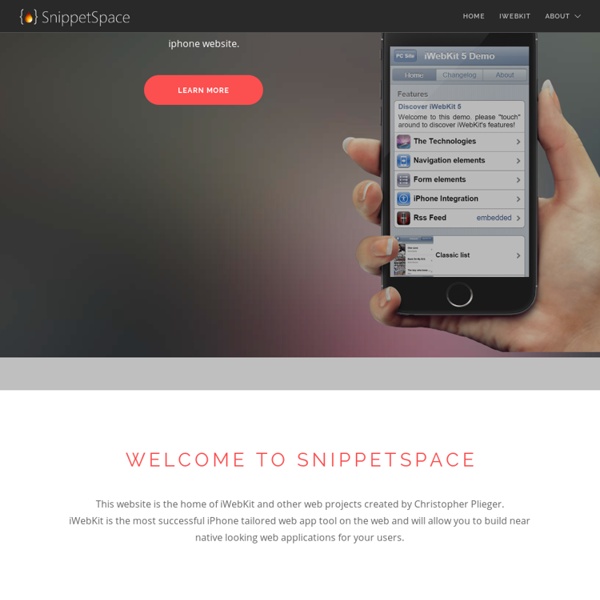



Creare un sito per iPhone con jQTouch e PHP Ultimamente mi stò avvicinando molto al mondo del mobile con molto entusiasmo sia per la semplicità con cui possiamo sviluppare le nostre applicazioni, sia per la minore difficoltà che si può incontrare nell’utilizzo di TAG e scripts. Nel mio caso, possedendo da tempo un iPhone, ho scoperto come sia davvero divertente sperimentare mini siti o proporre applicazioni da vendere ai miei Clienti utilizzando ottimi strumenti open source disponibili in rete e continuando a mettere in pratica le normali nozioni CSS, JavaScript e PHP di sempre. Non molto tempo fa, citai l’ottimo Framework jQTouch specifico per la creare applicazioni specifiche per iPhone i iPad e dunque proprio utilizzando lo stesso, vedremo oggi come creare da zero un sito ottimizzato per il device di casa Apple.
Onbile - Free mobile website templates Finding iPhone Memory Leaks: A “Leaks” Tool Tutorial There are plenty of different places to get a mobile application designed. The problem is that they’re quite expensive. You might be able to figure out how to create your own, but it will probably look very basic. Instead, a good mobile application development software can make it even easier, so that you can build great looking apps all by yourself. The Mobile design Starter Kit includes all the themes and scenarios you need to build whatever app you want. There are customizable and standard files that allow you to sell or offer anything you want through the kit. CSS Tip: Get Any Font You Want CSS Tip: Get Any Font You Want by Larisa Thomason, Senior Web Analyst, NetMechanic, Inc. Have your heart set on using a particular font on your site? You may think your online video sales Web site won't be complete without the "Showtime" font.
10 New Frameworks for Mobile Web App Developers One certain limitation in Web development is time and how long it takes to get things up and running. Thankfully, frameworks and libraries can help us focus on creating rather than figuring stuff out. Here, we’ve collected 10 frameworks and libraries that will help you save up your time and energy to create the actual website or application and make your web development more effective. The Most Useful Objective-C Code I’ve Ever Written « Vincent Gable’s Blog Actually, it’s the most useful code I’ve extended; credit for the core idea goes to Dave Dribin with his Handy NSString Conversion Macro. LOG_EXPR(x) is a macro that prints out x, no matter what type x is, without having to worry about format-strings (and related crashes from eg. printing a C-string the same way as an NSString). It works on Mac OS X and iOS. Here are some examples, LOG_EXPR(self.window.screen);
Rediscovering the Button Element Introduction Creating a consistent interface for your users is a constant struggle for every application designer. Building consistency on the web is especially tough because the visual rendering differences across browsers and operating systems are wildly different and almost arbitrary in what can and cannot be done. No where does this become more apparent than when you’re dealing with form elements and the biggest loser of them all in the battle for a standardized look is the infamous Submit button. As is, the input with the type=”submit” is either too ugly (Firefox), a little buggy (Internet Explorer) or completely inflexible (Safari). The solution for most is to use image inputs and create the damn things ourselves.
Create An HTML/CSS Mobile Web App Using Sencha Touch - Smashing Magazine Advertisement The world of mobile app development is quickly becoming a crowded and complicated space, especially for those outside of the development niche. “Which development platform should I use?” “Do I go native or Web-based?” “Which devices should I plan for?” A few things iOS developers ought to know about the ARM architecture « Wandering Coder When I wrote my Introduction to NEON on iPhone, I considered some knowledge about the iOS devices’ processors as assumed to be known by the reader. However, from some discussions online I have realized some of this knowledge was not universal; my bad. Furthermore these are things I think are useful for iPhone programming in general (not just if you’re interested in NEON), even if you program in high-level Objective-C. You could live without them, but knowing them will make you a better iPhone programmer. The Basics All iOS devices released so far are powered by processors based on the ARM architecture; as you’ll see, this architecture is a bit unlike what you may be used to on the desktop with x86 or even PowerPC.
BlueTrip CSS Framework